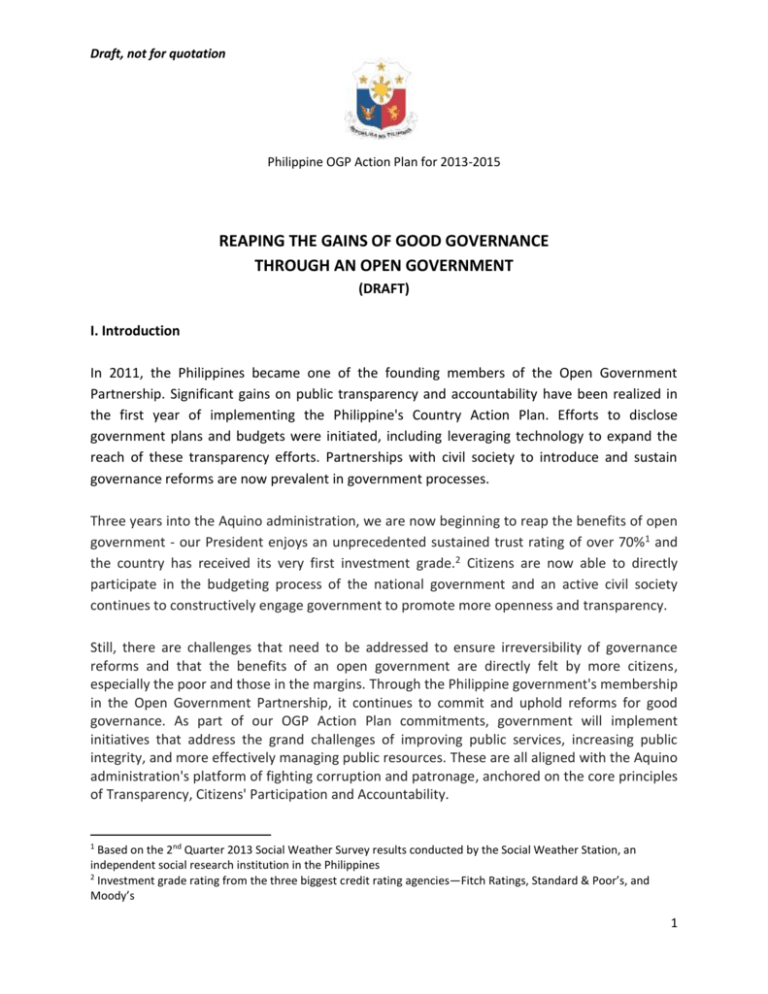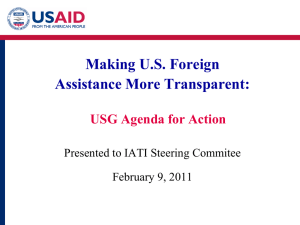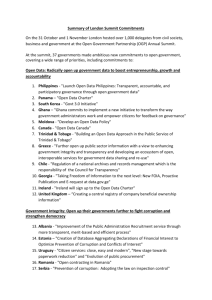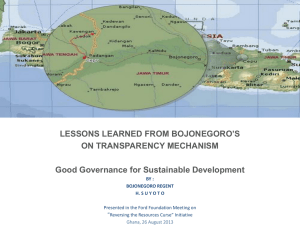OGP_Phl Plan as of 1014 - Open Government Partnership
advertisement

Draft, not for quotation Philippine OGP Action Plan for 2013-2015 REAPING THE GAINS OF GOOD GOVERNANCE THROUGH AN OPEN GOVERNMENT (DRAFT) I. Introduction In 2011, the Philippines became one of the founding members of the Open Government Partnership. Significant gains on public transparency and accountability have been realized in the first year of implementing the Philippine's Country Action Plan. Efforts to disclose government plans and budgets were initiated, including leveraging technology to expand the reach of these transparency efforts. Partnerships with civil society to introduce and sustain governance reforms are now prevalent in government processes. Three years into the Aquino administration, we are now beginning to reap the benefits of open government - our President enjoys an unprecedented sustained trust rating of over 70% 1 and the country has received its very first investment grade.2 Citizens are now able to directly participate in the budgeting process of the national government and an active civil society continues to constructively engage government to promote more openness and transparency. Still, there are challenges that need to be addressed to ensure irreversibility of governance reforms and that the benefits of an open government are directly felt by more citizens, especially the poor and those in the margins. Through the Philippine government's membership in the Open Government Partnership, it continues to commit and uphold reforms for good governance. As part of our OGP Action Plan commitments, government will implement initiatives that address the grand challenges of improving public services, increasing public integrity, and more effectively managing public resources. These are all aligned with the Aquino administration's platform of fighting corruption and patronage, anchored on the core principles of Transparency, Citizens' Participation and Accountability. 1 Based on the 2nd Quarter 2013 Social Weather Survey results conducted by the Social Weather Station, an independent social research institution in the Philippines 2 Investment grade rating from the three biggest credit rating agencies—Fitch Ratings, Standard & Poor’s, and Moody’s 1 Draft, not for quotation In crafting this Action Plan, on-line and public consultations with civil society organizations and business groups have been conducted. A Philippine-Open Government Partnership (Phl-OGP) Steering Committee was also created, composed of representatives from national and local governments, civil society organizations, and business groups that guided the crafting of this Plan.3 The Plan also benefitted from the recommendations provided by the Independent Reporting Mechanism (IRM) of the OGP. II. Open Government Efforts to Date In the implementation of the 2012 Country Action Plan that includes initiatives to promote an open government, significant gains were realized. Improved compliance with transparency National government agencies were mandated to publish major information on budgets, finance and performance indicators in their respective websites. As of first quarter of 2013, all departments in the Executive Branch have complied with the transparency mandate. Further, the Philippine Government Electronic Procurement System (PhilGEPS) currently include features such as an electronic bulletin board for posting of procurement activities, notices and awards, a registry of more than 70,000 suppliers, automatic bid matching of opportunities with possible suppliers, and a virtual store of common-use supplies available from the Procurement Service, the government’s bulk buyer. In addition, transparency in local governments was institutionalized through the adoption of the full disclosure policy which required local government units (LGUs) to post in a designated web portal, print media, and in conspicuous places information on their plans, budgets, and fund utilization reports. 9% of LGUs have fully complied with the policy in 2012, that is, they disclosed all required documents in the web portal, print media, and in conspicuous places in their respective areas. Further, 88% of LGUs have partially complied with the disclosure policy. Deepened citizens’ participation Civil society organizations were engaged in crafting the national budget by forging Budget Partnership Agreements (BPAs). In 2012, six national agencies and three government-owned corporations were included in the participatory budgeting exercise. This was expanded to cover twelve national agencies and six government-owned corporations in 2013. In addition, 595 3 Members of the Steering Committee are: National government-Department of Budget and Management, Department of Social Welfare and Development, and Department of the Interior and Local Government. Local government-Union of Local Authorities in the Philippines. Civil society organizations-Budget Advocacy Group, Task Force Participatory Local Governance, Right to Know-Right Now Coalition Business groups-National Competitiveness Council, Integrity Initiative 2 Draft, not for quotation cities and municipalities have undergone participatory planning and budgeting processes resulting to the identification of priority poverty reduction projects. More than US$195 million worth of projects, identified through a grassroots participatory budgeting process, have been incorporated in the 2013 national budget and are currently being implemented. Enhanced accountability and performance measurement systems A framework for a single results-based performance management system was developed, which includes a performance-based incentive system (PBIS) that was implemented on a pilot basis in 2012. The system includes the granting of performance-based bonus to government agencies that have complied with set good governance criteria and accomplished at least 90% of the agency’s physical targets. Participation rate of national government agencies in the PBIS is at 96% with more than 945,000 government employees granted with the performance-based bonus. Moreover, activities to monitor the compliance of government agencies in the Anti-Red Tape Act have been conducted. In 2012, 1,881 government service offices or 70% of total target have posted their Citizen’s Charters. With regards to local governments, the Seal of Good Housekeeping is conferred to LGUs that exercise transparency and sound fiscal management. In 2012, 1,365 LGUs were awarded with the Seal. Leveraged technology for transparency, efficiency, and accountability As one of the building blocks for the integrated financial management information system, the account code structures of government were unified and used in the preparation of the 2014 national budget. The design and implementation plan for the integrated system was also finalized in mid 2013. Further, the Electronic Transparency and Accountability Initiative for Lump-sum Funds (eTAILS), a page in the Budget Department’s website, was developed where citizens can access information on often-politicized lump-sum funds. An interactive website, called Budget ng Bayan4, where citizens can learn about and find information on the national budget was also developed. The site features an interactive people’s budget, budget cycle, and citizen’s portal. The People’s Budget, a less technical version of the national budget, was also published and disseminated to the public in 2012 and 2013. 4 Translated as people’s budget 3 Draft, not for quotation III. OGP Commitments The 2013-2015 Country Action Plan builds on the gains from the previous OGP commitments. It is composed of 6 continuing commitments and 3 new commitments5. The OGP Action Plan is aligned with the programs in the Philippine Development Plan and the Action Plan of the Cabinet Cluster on Good Governance and Anti-Corruption.6 The commitments under this plan and the Grand Challenges they address are summarized in Table 1. Table 1: Grand Challenges Addressed by Each Action Plan Commitments COMMITMENT Increasing Public Integrity More Effectively Managing Public Resources Improving Public Service Delivery Continuing Commitments 1. Sustain transparency in national government plans and budget 2. Support for the passage of legislations on access to information and protection of whistleblowers 3. Engage civil society in public audit 4. Enhance performance benchmarks for local governance 5. Enhance the government procurement system 6. Strengthen grassroots participation in local planning and budgeting New Commitments 7. Provide more accessible government data in a single portal and open format 8. Initiate fiscal transparency in the extractive industry 9. Improve the ease of doing business NUMBER OF INITITIATIVES 7 3 4 The Philippine OGP Action Plan commitments are described in the succeeding section. 5 Continuing commitments refer to commitments that are included in the 2012 Country Action Plan. New commitments may refer to new initiatives implemented by government in 2013 or already existing initiatives of government that were not included in the 2012 Country Action Plan 6 By virtue of Executive Order No. 43, the Cabinet is divided into five clusters that correspond to the five Key Result Areas (KRAs) identified in President Aquino’s Social Contract. 4 Draft, not for quotation CONTINUING COMMITMENTS 1. Sustain transparency in national government plans and budgets The 100% compliance rate of departments in the Executive Branch to the disclosure of their approved budgets and plans will be sustained. The disclosure is through the department's respective websites under the Transparency Seal. 2. Support for the passage of legislations on access to information and protection of whistleblowers The government commits to include in the priority legislation of the Executive two bills that promote access to information and protection of whistleblowers. Parallel activities will be conducted by civil society advocates to support the passage of the two priority bills. 3. Engage civil society in public audit The Commission on Audit will create an internal unit as a mode to institutionalize the engagement of civil society organizations in conducting participatory audits of government projects. For 2014, the Commission will jointly conduct four pilot audits of infrastructure projects with partner civil society organizations. 4. Enhance performance benchmarks for local governance The Department of the Interior and Local Government will enhance the existing performance review of local government units and expand benchmarks beyond financial practices. In 2014, all local governments will be assessed on five performance areas: (1) Good Financial Housekeeping; (2) Disaster Preparedness; (3) Social Protection for the Basic Sector; (4) Business-Friendly Environment and Competitiveness; (5) Environmental Compliance; and (6) Law & Order and Public Safety. 5. Enhance the government procurement system The current government electronic procurement system will be enhanced to include additional functionalities by 2014, such as facilities for uploading of bid document, electronic payment, and uploading of annual procurement plans. Registration of all national government agencies, state universities and colleges, and local government units in the government procurement system is targeted by 2014. 6. Strengthen grassroots participation in local planning and budgeting By 2014, 90% of all local government units have engaged grassroots organizations in the local planning and budgeting process. These local government units will have identified priority projects geared towards poverty reduction. By 2015, at least 70% of these projects would have been completed. 5 Draft, not for quotation NEW COMMITMENTS 7. Provide more accessible government data in a single portal and open format An Open Data portal will be launched that will feature dashboards and visualizations on selected government data presented in a more understandable format. Datasets available in the portal shall adopt open data standards. 8. Initiate fiscal transparency in the extractive industry Policies that will institutionalize fiscal transparency in the extractive industries will be enacted by 2014. The government also commits to publish a report disclosing the revenues of extractive industries and government revenues from these industries by May 2015. 9. Improve the ease of doing business By 2014, key indicators for ease of doing business would have improved. These include reducing the number of processing steps and days for starting a business, securing construction permits, getting electricity, registering property, paying taxes, trading across borders, enforcing contracts, and resolving insolvency. By 2016, the target is to bring the Philippines from the bottom-third of the rankings in the Doing Business Report to the top-third rank. Table 2 summarizes the nine commitments, their implementing agencies and their performance targets. Table 2: Summary of Commitment Performance Targets No. 1 Commitment Sustain transparency in national government plans and budgets Implementing Performance Targets (Year) Agencies* PCDSPO 1. 100% of national government departments fully complying with the Transparency Seal (2013-2015) Program: Transparency Seal 2 Support for the passage of legislations on access to information and protection of whistleblowers 3 Engage civil society in public audit PCDSPO, DOJ, PLLO COA 1. Freedom of Information and Whistleblowers Protection Bills included in the priority legislative agenda of the Executive (2015) 1. 4 participatory audits conducted and audit reports published (2014) Program: Citizens Participatory Audit 6 Draft, not for quotation No. 4 Commitment Enhance performance benchmarks for local governance Program: Seal of Good Local Governance 5 Enhance the government procurement system Implementing Performance Targets (Year) Agencies* DILG 1. Additional performance benchmarks on accountable, transparent, and participatory governance, and frontline service performance implemented (2014-2015) DBM Program: PhilGEPS Modernization 6 Strengthen grassroots participation in local planning and budgeting DILG, DBM, DSWD, NAPC 1. 100% registration of national government agencies, state universities and colleges, and LGUs in PhilGEPS (2014-2015) 2. Additional functionalities such as epayment, e-bidding, and uploading of procurement plans installed in PhilGEPS (2015) 1. 90% of total LGUs with identified priority poverty reduction projects (2014-2015) 2. 70% of projects completed (2015) Program: Grassroots Participatory Budget Process 7 Provide more accessible government data in a single portal and open format PCDSPO, DBM, OPS 1. Open Data portal launched (2013) 2. 300 data sets uploaded (2014) Program: Open Data Philippines 8 Initiate fiscal transparency in the extractive industry DOF 1. Policy to institutionalize transparency in the extractive industries adopted (2014) 2. Extractive industries transparency report published (2015) NCC 1. Starting a business - No. of steps and days reduced to 10 2. Dealing with construction permits - No. of steps reduced to 16 - No. of days reduced to 71 Program: Philippine Extractive Industries Transparency Initiative 9 Improve the ease of doing business Program: Gameplan for Competitiveness 7 Draft, not for quotation No. Commitment Implementing Agencies* Performance Targets (Year) 3. Getting electricity - No. of steps reduced to 4 - No. of days reduced to 36 4. Registering property - No. of steps reduced to 6 - No. of days reduced to 21 5. Getting credit - Depth of credit information index increased to 6 - Strength of legal rights index increased to 10 6. Protecting investors - Extent of disclosure index increased to 7 - Extent of director liability index increased to 9 - Ease of shareholder suits index increased to 10 7. Paying taxes - No. of payments reduced to 14 - No. of hours to prepare and file returns and pay taxes reduced to 193 8. Trading across borders To export: - No. of documents reduced to 5 - No. of days reduced to 7 To import: - No. of documents reduced to 6 - No. of days reduced to 7 9. Enforcing contracts - No. of steps reduced to 30 - No. of days reduced to 326 10. Resolving insolvency - Time reduced to 2.7 years *Acronyms: COA – Commission on Audit DBM – Department of Budget and Management DILG – Department of the Interior and Local Government DOF – Department of Finance DOF – Department of Finance DOJ – Department of Justice DSWD – Department of Social Welfare and Development NAPC – National Anti-Poverty Commission NCC – National Competitiveness Council OPS – Office of the Presidential Spokesperson PCDSPO – Presidential Communications Development and Strategic Planning Office PLLO – Presidential Legislative Liaison Office 8








